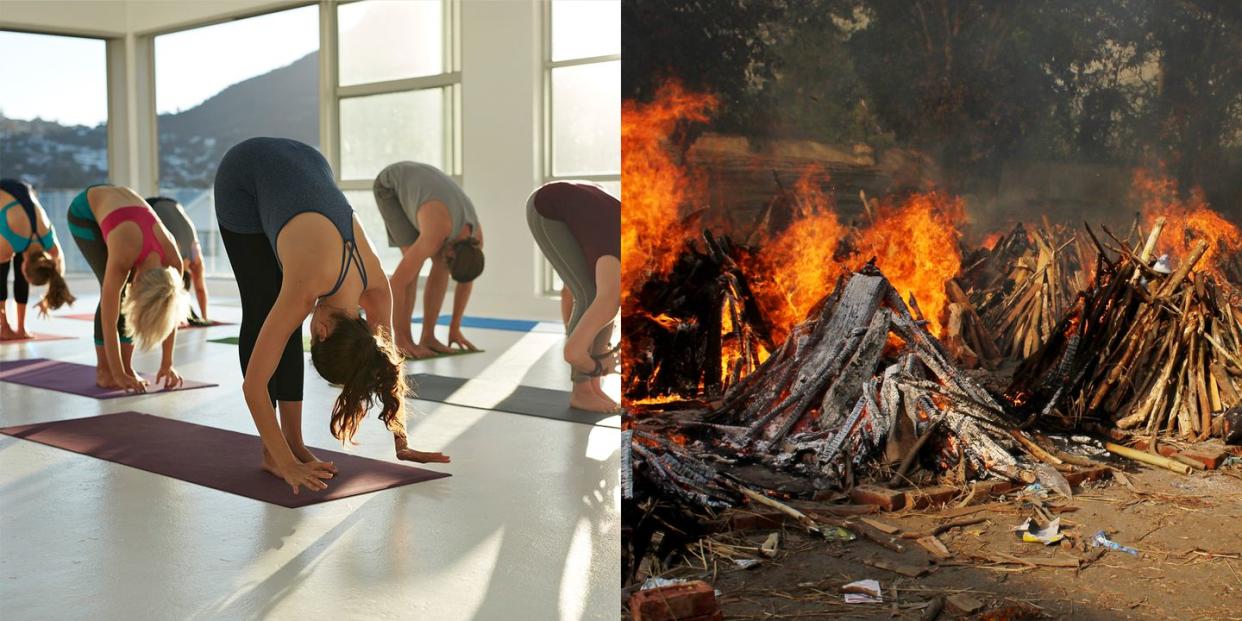There’s a COVID-19 Crisis in India—and the Yoga Community Is Nowhere to be Found

It might have slipped your mind that in 2018, Gwyneth Paltrow made the very bold and outlandish claim that she singlehandedly popularized yoga. Allow me to remind you that she definitely did just that. In an interview with the Wall Street Journal, she said:
“Forgive me if this comes out wrong, but I went to do a yoga class in L.A. recently and the 22-year-old girl behind the counter was like, ‘Have you ever done yoga before?’ And literally, I turned to my friend, and I was like, ‘You have this job because I’ve done yoga before.’”
There was, of course, backlash. I mean, she completely erased the generations of Indian people who’ve practiced yoga for, oh, thousands of years. As in, thousands of years before Goop was even a thought?! Anyway, this is a textbook example of how white people have appropriated and commodified yoga, their version of which is typically defined by expensive leggings and post-flow golden lattes.
Those same people are ignoring the COVID-19 crisis happening in India right now. The country is shattering global infection records, and the pandemic shows no signs of letting up there. The vastly underreported death toll—at more than 200,000—is being called a “complete massacre of data” and could be up to five times more, according to epidemiologist Bhramar Mukherjee’s statement to the New York Times.
Thinking of all the yoga instructors i follow who have not acknowledged the humanitarian crisis in India but encouraging you all to attend their Vinyasa Flow
— Haf (@hafandhafandhaf) April 29, 2021
Many popular yoga instructors, most of whom are white, have turned the practice into successful and lucrative online businesses. Just look at Yoga with Adriene or Dylan Werner Yoga or Boho Beautiful or the hundreds of other YouTube personalities and IG influencers. But it feels like no one in the yoga community—or at least the very online, commercialized, social-media-focused part of it—is acting with urgency to support the very country and the people who are responsible for their livelihoods. Instead, they’re posting pics of their headstands with vague captions like, “Finding my inner peace. 🙏”
And that’s to say nothing of the predominantly white yoga-obsessed influencers and die-hards—according to a 2012 Yoga Journal study, more than four-fifths of people who practice yoga are white—who have om tattoos, love turmeric detox juice, and own “Nama-stay in bed” T-shirts/mugs/posters. Why aren’t these people stepping up for Indians, whose culture they’re cherrypicking from?
The rate of new cases in India is as high as 350,000 per day, with more than 18 million people infected—and, as mentioned before, experts say those figures are conservative ones. Those are only the numbers being reported. Oxygen scarcity is forcing many to try to obtain some on the black market to save loved ones. People are doubled up on hospital beds—if they’re lucky enough to even be admitted. Fires burn at all hours of the day and night, cremating the countless bodies that are piling up. Many Indians are essentially terrified and trapped at home, wondering when, not if, the virus will get to them.
It’s really disheartening to only see fellow South Asians talking about the crisis in India right now. Where’s the fire in Notre Dame energy? Where’s the covid in Italy energy? Where’s the yoga and “chai tea” energy?
— Vaishnavi Patel (@VaishnaWrites) April 29, 2021
To put it even more in perspective, India’s population is 1.4 billion. It is a full-blown humanitarian crisis and, scary as it sounds, the pandemic there has the potential to get far worse than we can imagine.
So to the yogis out there preaching “care,” “love,” and “togetherness” but who haven’t shared resources about how to help or learn more about the pandemic in India, your silence is hypocritical and downright cruel. Instead of posting your new Ashtanga yoga flow with a guided meditation on your YouTube channel (#LikeAndSubscribe, right?), how about recognizing the dire situation in India and raising awareness of resource and fundraising efforts? In the meantime, below are some ways to help:
Give India Covid Relief Fund is helping deliver oxygen, donating food to families in need, and supporting families of the deceased.
PATH is working to scale up vaccines, deliver oxygen generators, and more.
The International Medical Corps is providing medical supplies, personal protective equipment (PPE), sanitation and hygiene supplies, and isolation facilities.
Care India is a humanitarian organization providing PPE kits and medical equipment to hospitals and care facilities where they’re needed most.
The Indian Red Cross Society is providing aid and medical supplies across the country with the help of volunteers.
You Might Also Like

